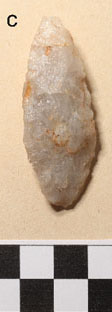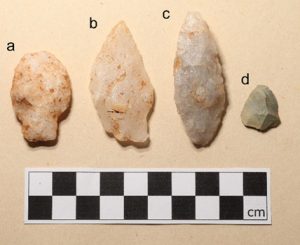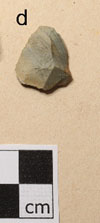Points from Powhatan Co.

Ask an Archaeologist:

The son of Sarah and James Reilly in Powhatan found the points shown in the photo at the top of this post and the family asked what DHR could tell them about the items. Sarah writes:
When we started building our house, we used a trencher to install a silt fence around the lower perimeter of the clearing, digging about 8 inches down in the process. We found three quartz points (Figures 1-a, -b, -c, and -d) in the debris dug out from the trench.
The fourth point, the gray one (Figure 1-d) was found on the surface after the clearing was made [and not] associated with the silt fence trench. . . . We know this entire area was plowed in the past.
Sarah also provided the general long and lat coordinates for the location. She also submitted two photos (below) of an intriguing rock they found.
DHR responds:
Sarah and James,
Thanks so much for the photos and the info to go with them. It seems like you all have very scientific minds! The photos are great, with a professional looking scale, and the fact that you checked the specific gravity of the stone (2.27) is fantastic!
Let’s start with the easy bit. That "chunky thing" is a piece of a soapstone bowl.
It seems to have had lots of inclusions that have weathered away. This could possibly help us identify the source of the raw material. Previously, I’ve posted about soapstone bowls. If you compare your piece and the one in the photo in that posting you will see a big difference in the surfaces. One is very smooth and the other quite degraded. This may be related to the source or possibly the conditions to which one stone (yours) has been exposed.
Much of the soapstone in the lower Piedmont likely comes from Brunswick County, which is not far from Powhatan. The soapstone there is a very high quality and quarrying it has even continued into modern times. There is a smaller and lesser-known soapstone quarry site in Goochland County (which abuts Powhatan) that has not previously been examined very closely. That spot is even closer to your home. I plan to investigate it and I’ll report back to you if the material looks like yours.
The points are difficult to identify, especially the first two, because of how damaged they are. Two initial components for identifying points are the “stem” (the lower portion) and the “notching” on the sides. With the stem it depends on the general shape (width, length, thickness) and often whether it’s been thinned by grinding it down at the very bottom or flaked. All of that can mean something. Then there is the question of how the stem is notched. Is it notched on the side or from lower down at the bottom? And what is the shape and depth of the notch? There also is a lot of variation within how it is made. The shape of the blade portion can also be helpful. Some are rounded, some quite straight.
What I see right away with your points is the dominance of white quartz in three of them (1-a through -c). That makes sense given your location in Powhatan County, where quartz is abundant.
The fourth piece (1-d) in the photo is rhyolite.
Rhyolite is not uncommon to find in Virginia’s lower Piedmont and it makes a good material for tool production. This variety of rhyolite is often called Carolina Slate because it comes from a swath of base lithic (stone) material that runs from South Carolina through to the North Carolina–Virginia border. Geologists call it the Carolina Slate Belt. Rhyolite is an igneous volcanic rock with varying textures and colors. A lot of the rhyolite from the Carolina Slate Belt is “banded” or striped like the piece you found, which, I believe, is a flake of the banded rhyolite. It almost fooled me, as it appears similar to the base of a Morrow Mountain (I and II) point. But it likely is just the leftovers from someone making a tool.
As for the other points, 1-a may be a Bare Island Point; 1-b could be a Savannah River; and 1-c, I think, is a Poplar Island. Of course 'a' and 'b' have missing components that make them tough to definitively identify, and you’d likely get several different opinions from other archaeologists. 1-a is tough because it’s missing much of the length of the blade portion, and it may have been put to other uses as a scraper or something that has worn it quite round. 1-b is missing the base of the stem and one of the notches. 1-c is in the best shape and fairly easy to identify.
Each of the identified points comes from the period we call Late Archaic. That means these points are between 3,500 and 5,000 years old or so. Here’s a good guide to the time periods.
DHR’s website can help you in identifying points. Be careful with online searches for point and tool identification. There are many misleading sites out there. Stick to ones connected to state agencies or universities.
Thanks again. These are really nice finds. It looks like maybe your home site was a popular stopping place thousands of years ago for people who were moving through the area as they made their seasonal rounds searching for food.
–Mike Clem,
Eastern Region Archaeologist, DHR











